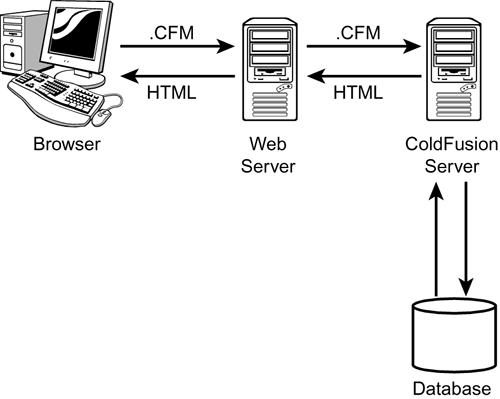| ColdFusion has three basic components : the server, the administrator interface, and ColdFusion Markup Language (CFML). The server is the central element. You use the browser-based administrator interface to manage the server. You use CFML in Web pages destined for the ColdFusion server in much the same way that HTML pages are destined for Web servers. The ColdFusion server runs side by side with a Web server. As the Web server displays pages, the ColdFusion server watches for ColdFusion pages (pages with the .cfm extension). ColdFusion pages contain a mixture of standard HTML and CFML. The ColdFusion server grabs the ColdFusion pages, turns them into pure HTML, and returns them to the Web server for display. (See Figure 32.1.) Figure 32.1. The ColdFusion server takes .cfm pages that come to the Web server, performs dynamic data operations (insert, update, retrieve, delete) based on the ColdFusion Markup Language (CFML) in the .cfm file, and returns pure HTML to the Web server, which forwards it to the browser. 
While it has the page in its possession, the ColdFusion server can do four basic types of things: -
Database operations , such as retrieving, inserting, updating and deleting data in databases stored on the server. This is the central function of the ColdFusion server. It allows the Web developer to populate Web pages with data from databases created with database management systems such as MySQL, Microsoft Access, or SQL Server (and many others). -
File operations , such as reading, writing, and appending to text files, including HTML, XML, and CFML files, that are stored on the server. This means that the developer isn't limited to database information, but can get at anything that's stored in a text file. The ColdFusion server can also upload files to the server from clients . -
Server-to-server communications , in which the ColdFusion server exchanges data with other servers, including other ColdFusion servers, servers running Flash Remoting software, and directory servers that use Lightweight Directory Access Protocol (LDAP). It can also communicate with SMTP servers, allowing it to send and receive email. When you use Simple Object Access Protocol (SOAP) to access Web services, the ColdFusion Server also provides a proxy service, which replicates the functions of the Web service. You can create the proxy in 30 seconds using Dreamweaver.  For instructions on creating the Web services proxy, see "Consuming Web Services," in Chapter 13, page 316 . For instructions on creating the Web services proxy, see "Consuming Web Services," in Chapter 13, page 316 .
-
Page processing and display operations , which are numerous and varied, including text formatting, search and replace, and building tables, forms, and charts . ColdFusion can also change information in HTTP headers, which can instruct the Web server to do various things such as prompt the user for a response, or purge the HTML file from its cache after displaying it. |